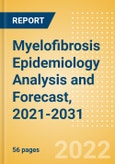Myelofibrosis (MF) belongs to a group of diseases called myeloproliferative disorders. MF is a serious bone marrow disorder that disrupts the body's normal production of blood cells (MedlinePlus, 2020; Mayo Clinic, 2021). MF includes primary MF (PMF), which is idiopathic. At times, essential thrombocytosis (ET) or polycythemia vera (PV) could progress to MF, resulting in post-essential thrombocytosis MF (PET MF) and post-polycythemia vera MF (PPV MF), which are referred to as secondary MF (SMF). MF not only shortens survival but also severely compromises quality of life due to marked splenomegaly and profound constitutional symptoms including fatigue, night sweats, fever or uncomfortable feeling of warmth, weight loss, peripheral edema, pruritus, bone pain, dyspnea, and intractable cough (Mesa et al., 2009; Canadian Cancer Society, 2022).
In the 8MM, diagnosed incident cases of MF (sum of the diagnosed incident cases of PMF and SMF) are expected to increase from 12,276 cases in 2021 to 15,009 cases in 2031, at an Annual Growth Rate (AGR) of 2.23%. In 2031, China will have the highest number of diagnosed incident cases of MF in the 8MM, with 9,302 cases, whereas Spain will have the fewest diagnosed incident cases of MF with 413 cases. In the 8MM, the diagnosed prevalent cases of MF (sum of the diagnosed prevalent cases of PMF and SMF) are expected to increase from 69,236 cases in 2021 to 84,311 cases in 2031, at an AGR of 2.18%. The publisher's epidemiologists attribute the increase in the diagnosed incident cases and diagnosed prevalent cases of MF to changes in the diagnosed incidence and survival rates, and population dynamics in each market.
In the 8MM, diagnosed incident cases of MF (sum of the diagnosed incident cases of PMF and SMF) are expected to increase from 12,276 cases in 2021 to 15,009 cases in 2031, at an Annual Growth Rate (AGR) of 2.23%. In 2031, China will have the highest number of diagnosed incident cases of MF in the 8MM, with 9,302 cases, whereas Spain will have the fewest diagnosed incident cases of MF with 413 cases. In the 8MM, the diagnosed prevalent cases of MF (sum of the diagnosed prevalent cases of PMF and SMF) are expected to increase from 69,236 cases in 2021 to 84,311 cases in 2031, at an AGR of 2.18%. The publisher's epidemiologists attribute the increase in the diagnosed incident cases and diagnosed prevalent cases of MF to changes in the diagnosed incidence and survival rates, and population dynamics in each market.
Scope
- This report provides an overview of the risk factors, comorbidities, and the global and historical trends for MF in the eight major markets (8MM: US, France, Germany, Italy, Spain, UK, Japan, and China).
- It includes a 10-year epidemiological forecast for the diagnosed incident and diagnosed prevalent cases of MF, PMF, PET MF, and PPV MF based on county-specific studies published in peer-reviewed journals. The diagnosed incident cases of PMF are further segmented by sex, age (40-49 years, 50-59 years, 60-69 years, 70-79 years, and =80 years), the mutation-enhanced international prognostic scoring system (MIPSS70+) version 2.0 [very low risk (0 points), low risk (1-2 points), intermediate risk (3-4 points), high risk (5-8 points), and very high risk (=9 points)], mutations (JAK2V617F, CALR, and MPL), and anemia (with or without). The diagnosed prevalent cases of PMF are segmented by sex and age (40-49 years, 50-59 years, 60-69 years, 70-79 years, and =80 years). The publisher's epidemiologists also provide sex-specific diagnosed incident and diagnosed prevalent cases of PET MF and PPV MF in the 8MM for the forecast period.
- The myelofibrosis epidemiology report is written and developed by Masters- and PhD-level epidemiologists.
- The Epidemiology Report is in-depth, high quality, transparent and market-driven, providing expert analysis of disease trends in the 8MM.
Reasons to Buy
The Myelofibrosis Epidemiology series will allow you to:- Develop business strategies by understanding the trends shaping and driving the global myelofibrosis market.
- Quantify patient populations in the global myelofibrosis market to improve product design, pricing, and launch plans.
- Organize sales and marketing efforts by identifying the age groups that present the best opportunities for myelofibrosis therapeutics in each of the markets covered.
- Understand magnitude of myelofibrosis by MIPSS70+ v2.0 risk categories, mutations, and anemia
Table of Contents
1 Myelofibrosis: Executive Summary
2 Epidemiology
3 Appendix
List of Tables
List of Figures








